Introducing the Elf
Air Date: Week of January 11, 2013
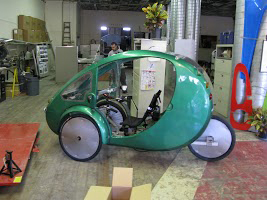 |
ELF stands for Electric, Light and Fun. And as Living on Earth's Helen Palmer reports, the ELF is a new invention, a solar and human powered covered tricycle that might just help create a commuting revolution, and combat climate change as well.
Transcript
CURWOOD: So, among your new year's resolutions - maybe there's one that has to do with getting more exercise - getting out on a bike perhaps. But the dangers of bike riding in the short dark days of winter and the problems of arriving disheveled can put you off. Well, today we report on a new invention that could be an answer for those problems, the Elf.
[SOUNDS FROM VIDEO CLIP: ‘Made in the USA, the Elf is a revolutionary vehicle powered by you and the sun, designed to make your commute more fun, practical, and affordable than ever before. It can legally go anywhere a bike goes, and its three-wheeled stability allows for tight cornering and easy transitions from trail to the street.’]
CURWOOD: That video is from the Kickstarter campaign launched to raise $100,000 to get the Elf off - or rather I should say on the ground. It sounded intriguing enough to send Living on Earth's Helen Palmer on the road.
[TRAFFIC SOUNDS]
PALMER: Organic Transit - that makes of the Elf - occupies an old furniture warehouse in downtown Durham, North Carolina. In the huge showroom window is what looks like a large green egg-shaped motor-cycle side car on top of a racing wheel-chair. Now, a sun-powered tricycle sounds like the brain-child of a young alternative engineer, but its inventor hardly fits that mold.

Inventor Rob Cotter shows reporter Helen Palmer the ELF. (Photo: Joanna Rifkin)
COTTER: Hi Helen, I'm Rob Cotter with Organic Transit.
PALMER: Rob Cotter is in his 50s, a slightly rumpled and unassuming-looking engineer with plenty of hands-on experience.
COTTER: Many years ago I was working for Porsche and BMW more on the race-car side of things - and I was living in Southern Calif.- and they were building the Gossamer Condor and Gossamer Albatross - the pedal-powered aircraft - not too far from me, so I kind of linked up with those folks.
PALMER: That led to a host of new possibilities - Cotter's a working inventor who's learned many skills along the way.
COTTER: I became vice president of land for human-powered vehicles, I built a 62mph tricycle about 30 years ago, and from that point on I built lots of funky little vehicles, I learned plastic forming and composites, I put on first solar-powered races in the US - and once I realized you could go highway speeds at one horse power - I realized how inefficient everything is that we do.
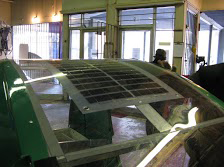
Solar Panels on top of the ELF. (Photo: Joanna Rifkin)
PALMER: That realization and all that experience went into making this new alternative vehicle, the Elf – not something from Lord of the Rings – but an acronym.
COTTER: It's actually Electric, Light and Fun.
PALMER: Light and fun - but not tiny.
COTTER: It's under 4 feet wide, 8 feet long and a little under 5 feet tall.
PALMER: At that height, he says, you sit in traffic at eye level with cars. The open sides and huge front windshield mean you can see, and the electric headlights and indicators mean you can be seen; you're protected by a sturdy aluminum frame that anchors the body panels front and back. There's space behind the driver to put a child seat and it can carry up to 350 pounds of cargo, but the Elf is still a bicycle.
COTTER: It has pedals and a chain and drives a rear wheel, but there's also solar panels and an electric motor to help get it down the road.
PALMER: Or up the hill?
COTTER: Yes - or longer distances or carry lots of - you know - cargo.

Steering handles and pedals on the ELF. (Photo: Joanna Rifkin)
PALMER: Rob says the Elf gives people the choice of how much exercise to take - you can use the electric motor to help get up the hills on the way to work - so you don't arrive too sweaty - then let it sit in the sun for the solar panels to charge the battery. And it's not only the Elf's color and its power source that are green.
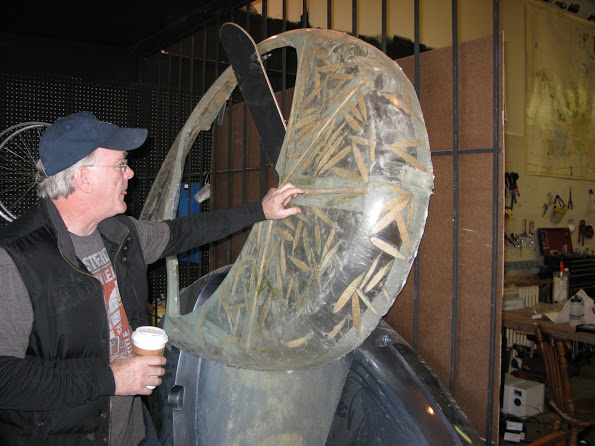
Rob Cotter with ELF side panel; note embedded bamboo leaves. (Photo: Joanna Rifkin)
COTTER: A lot of materials that go into this are recycled materials - as time goes on we're going to use more biological materials - like hemp and seagrass but currently we're using recycled plastic, the aluminum's 45 percent recycled, it's a very efficient package - so efficient that it gets the equivalent of 1800 mpg.
PALMER: But, of course, it uses no gas at all - just human-power, sun-power - and a battery pack with a 30 mile range. It's not built for highways though - only for local roads, and bike trails, as federal regs say a bicycle can't go faster than 20 miles an hour. Cotter says if enough people who drive about 30 miles a day climbed out of their cars and into an Elf - the effect on greenhouse gas emissions could be startling.
COTTER: Each one of these on the road takes about 28 tons of CO2 out of the atmosphere per year.
PALMER: Compared with an equivalent car?
COTTER: That's right, it mitigates the 28 tons - so 100 of these on the road are equivalent to a 4 megawatt wind turbine at about 20% of cost.
PALMER: Ah cost! That's always one of the big questions about any new technology.
COTTER: The base price is $4000 - and basically that's like the wholesale price - but we have over 400 orders or reservations currently, just from our website.
PALMER: And that was before the Kickstarter campaign got underway - they reached their $100,000 funding goal in 12 days and 40 people have actually paid for the vehicles. There's lots of buzz - indeed, one benefit of a store-front is people walk by, see the Elf in the window -- and are intrigued.
[STOREFRONT SOUNDS]
PALMER: I grabbed a couple of window-shoppers…excuse me - what do you make of this?
MORRIS: Well I think it's fascinating - it's kind of intriguing that you can be covered, and fully protected - and still just peddle your way to work or wherever…
PALMER: How about you?
BERM: I think it's exciting - when I was a little kid - I wondered could you make a car from a bicycle - to me this is the sci-fi orgasm of the future is now - and I would love to have one!
PALMER: That's Tim Morris and Steve Berm. Steve's a school-teacher; for now he commutes too far on major highways to make an Elf practical, but he says it could be a perfect set of wheels for his wife. And it's not only casual passers-by who see the Elf and like what they see. Bill Chameides, the Dean of the Nicolas School of the Environment at Duke University envisions the Elf helping green the campus.
CHAMEIDES: Well I think it's such a wonderful wonderful concept. First of all we want people to get out and bike and it’s good for their health and good for the environment, but riding a bicycle's problematic, you're out in the open, you don't have protection from the sun and this wonderful invention, the Elf – you're actually enclosed just like a little tiny car and you've solar power assistance to get up the hills. I think it's a great idea - I would love to set up a thing where for example we had some of our students at the Nicolas School living in downtown Durham and did the trek over to the Duke Campus, which is a few miles and using these little Elfs back and forth, what a great, great idea.
PALMER: Prof. Chameides says students aren't the only ones who could benefit. This kind of invention could give everyone from aging baby-boomers to youngsters greater mobility, as well as helping to fight global warming. Back at Organic Transit's downtown factory, Rob Cotter explains another important feature of the Elf.
COTTER: We're trying to figure out basically how to do a bike factory in a box where we can - you saw how they nest together - and ship and things like that that makes them very transportable and be utilized by assembly points in downtown locations by low-skilled labor.
PALMER: To make that possible, the Elf needs to be as modular as possible, with pre-formed components - the frame, the electronics, and the body - designed to just bolt or clip together. Rob pointed to the pile of panels along the sides of the showroom.
COTTER: This is one of the trilon bodies, so trilon is a composite of acrylic and recycled ABS.
PALMER: What's ABS?
COTTER: A very conventional plastic - so this is a vacuum formed body, so whereas those other ones like that green one there takes us about 2 days - these pop out every 20 minutes.
PALMER: They're making them all locally - along with the wiring for the battery and the electronics, designed by mechanic Biran Highfill.

Mechanic Brian Highfill with reporter Helen Palmer. (Photo: Joanna Rifkin)
HIGHFILL: Right now I'm trying to make a bunch of quick disconnects, so if your turn signal switch breaks you just unplug it.
PALMER: What kind of training do you have to have for this?
HIGHFILL: I graduated from Nascar tech Inst – I’ve been a bicycle mechanic for 10 years.
PALMER: So you could do race cars - but you're doing bikes instead?
HIGHFILL: Yeah.
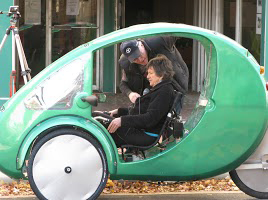
Instruction from Rob Cotter (Photo: Joanna Rifkin)
PALMER: By now I really wanted a personal test-drive in this powered trike – though I was a little apprehensive.
COTTER: We call the green one the green onion.
PALMER: How safe do you think they are if somebody runs into them?
COTTER: Safer than a bicycle! Actually, from years of dealing with human-powered vehicles decades ago we realized that aero-dynamic skin is very safe, so when people crashed at 60 and 70 miles an hour - nothing happened to them – so this is like riding inside a bike helmet. So let me pop this door open here…
PALMER: But with hands full of recorder and microphone - I wasn't sure if I could actually ride or steer the thing - indeed - I couldn't even work out how to climb into it.

"Where can I put the microphone?"
Helen Palmer prepares to test-drive the ELF.
(Photo: Joanna Rifkin)
COTTER: So what I do - it's kind of like getting into a kayak - so I take a big step - keep your feet on the pedals - it's much the safest to keep your feet on the pedals.
PALMER: So, feet on the pedals - and microphone stuffed inside my jacket - I was ready:
COTTER: So make a left at light - up to the bull - see that bull statue? Make a right after that.
PALMER: And I set off pedaling unsteadily into the traffic..
Wow – I’ve come to red light so I’m stopping - she's letting me go. That’s amazing. I'm turning in front of the traffic. Oh, wow! This is very wonderful. OK it’s quite a bit of actual pedaling so it’s not easy - but I could put on electric motor so let’s try that. Oh, yes I just put the motor on and it’s great! Ok, there’s nothing coming so I can turn round here Oh it’s easy! You get the hang of it in like three minutes. Oh - I'm being followed by a fire engine.
Well - except for the fire-truck, it was fun, but more challenging than I'd expected and given the turn signals and the traffic, there was a lot to remember. But it's certainly easier than learning to ride a bike - and the electric power on the hills was great. It also makes a stir. People stood and watched me weave my way down Durham's Main Street. One of them was Vince Provenzano…
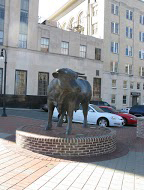
Durham's mascot - the Bull. (Photo: Joanna Rifkin)
PROVENZANO: I thought it was amazing - I'm ecologically–minded, and to see something like that? It's just phenomenal! I was curious as to how much peddling you have to do versus how much energy is stored in battery
PALMER: Well, I have to say, from going round the block, it’s harder to pedal than I'd expected. But, when I came to the hill, I of course put on the battery assist and it shot up the hill! It was great!
PROVENZANO: I think it's phenomenal but it's a great combination mode of transportation: You can exercise, and better yet if you need to go off solar power, just go off solar power. And why not? Takes you outside!
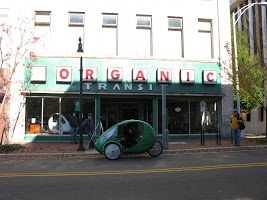
The Elf outside Organic Transit's showroom (Photo: Joanna Rifkin)
PALMER: Over 400 people seem to agree it's a worthwhile enterprise - they supported the Kickstarter campaign and may have helped assure its future. So don't be surprised to see a solar-pedal-powered trike heading down a bike-path near you soon. For Living on Earth, I'm Helen Palmer in Durham, North Carolina.
Links
Living on Earth wants to hear from you!
Living on Earth
62 Calef Highway, Suite 212
Lee, NH 03861
Telephone: 617-287-4121
E-mail: comments@loe.org
Newsletter [Click here]
Donate to Living on Earth!
Living on Earth is an independent media program and relies entirely on contributions from listeners and institutions supporting public service. Please donate now to preserve an independent environmental voice.
NewsletterLiving on Earth offers a weekly delivery of the show's rundown to your mailbox. Sign up for our newsletter today!
 Sailors For The Sea: Be the change you want to sea.
Sailors For The Sea: Be the change you want to sea.
 The Grantham Foundation for the Protection of the Environment: Committed to protecting and improving the health of the global environment.
The Grantham Foundation for the Protection of the Environment: Committed to protecting and improving the health of the global environment.
 Contribute to Living on Earth and receive, as our gift to you, an archival print of one of Mark Seth Lender's extraordinary wildlife photographs. Follow the link to see Mark's current collection of photographs.
Contribute to Living on Earth and receive, as our gift to you, an archival print of one of Mark Seth Lender's extraordinary wildlife photographs. Follow the link to see Mark's current collection of photographs.
 Buy a signed copy of Mark Seth Lender's book Smeagull the Seagull & support Living on Earth
Buy a signed copy of Mark Seth Lender's book Smeagull the Seagull & support Living on Earth

